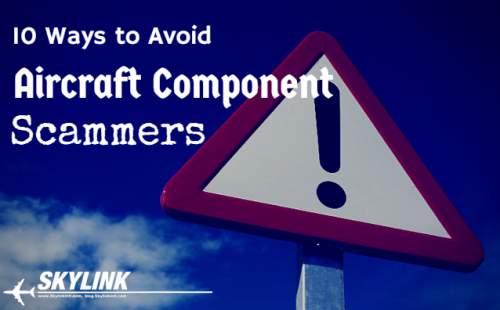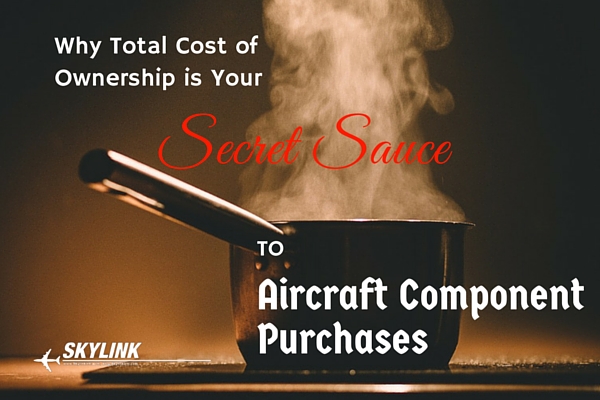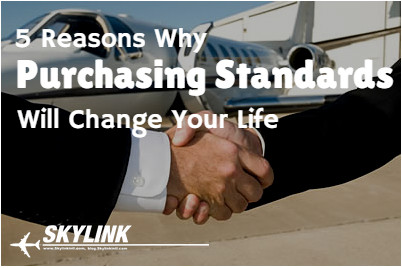What’s an aircraft part exchange? Without boring you and breaking out the technical dictionary, it’s a mechanism where you receive a serviceable component and return an unserviceable core at a later date.
Why Mechanics & Pilots Must Communicate after Critical Maintenance
Most of us, yes, you included, get so caught up in your day that we forget how important effective communication is. Effective being the key word there.
Challenges & Opportunities in PBH Fleet Component Programs
5 Reasons Why Purchasing Standards Will Change Your Life
Did you know you’re urgent day-to-day routine effects your purchases? Your urgency helps tasks but leaves you rushing and lowering your purchasing criteria. Often price is your main objective. As long as you have the cheapest price you’re happy. Right?
Being “cheap” cost you more than you think. Rushing your buying process and only shopping for the best price you’re missing out on quality and value. Rushing when purchasing makes you an emotional buyer and that can cost you tons of money in this game.
Create yourself purchasing standards.
Here are 5 reasons why purchasing standards will change your life.
Keeps You on Target
When you purchase on emotion, you purchase with what you “think” is the best decision. Hormones play with your mind.
Emotions will overrule your best long-term decision.
Creating a purchasing standard, you’ll commit yourself to overall excellence. You’ll avoid making fast, emotional decisions that lead you to heartache and pain.
Helps Avoid Scammers
I’ve said it before and I’ll say it again, aircraft component scammers are active and ready to take your time and money. It’s a fact of life.
One of the best ways to avoid scammers is with a purchasing standard. When you set standards you create a blueprint for excellence. You create an ideal world. A preferred supplier persona.
[Tweet "When you set standards you create a blueprint for excellence"]
More Focused on Total Cost of Ownership
Direct cost and lead time is how you make your decisions. Both of these are incredibly important but so is the total cost of ownership. Once you set your purchasing standards, you’ll have a guide that helps you make the best overall decision. Direct costs are often used as a vanity metric. Total cost of ownership is your primary metric for purchasing excellence.
Reduce Processing Costs
Processing costs are a part of the total cost of ownership but they play a critical role here.
Orders being processed are often followed by a huge productivity slump. After an RFQ (request for quote) is created, competing quotes are received, the order is placed and issues resolved. Productive time is literally flushed down the toilet.
Once you have your purchasing standards created, you’ll reduce time and money processing orders. You’ll have a fluid process to go to every time.
Better Decisions
As orders are being placed, you’ll make better decisions on what components to purchase. You’ll be faster at solving problems as they pop up.
You live in aviation. Issues happen but solving them fast and with least financial impact is critical. Your purchasing standards will help guide you through this process. It’ll tell you how to handle such problems.
I find that most problems are unique as a standalone issue, but they all follow the same decisions making process.
Creating purchasing standards for your aircraft components will help save you time and money over the life of your purchases. It’s their guide to you, to be your point of reference in times of difficulty.
First start by working with a partner who embodies everything you would want in an ideal vendor. They reply to you fast, they have what you want, when you want it. They accept problems and solve them not leaving you to figure it out all alone. That’s an ideal vendor. A true partner.
Once you have that, start by creating your purchasing standards on the ideals they represent. Simple!
10 Ways to Avoid Aircraft Component Scammers
We’ve all been there. You purchase an aircraft component and never receive it. You've been scammed. Or you receive something that’s vastly different than what you ordered.

In either case you've been duped, tricked, and fooled into paying for something that was a lie.
Money is thrown in the garbage and you’re left having to fix it.
You think you’re alone when this happens. Sadly, you're not alone.
A few years ago we bought an INU for $15,000. The "company" was based out Atlanta. GA.
Before paying we revised the airworthiness certa. Everything checked out. The vendor sent us an AWB.
The next day, nothing showed up and nothing tracked. We called the local FedEx branch and they said they have a guy on video coming back to pick up the part.
We were officially scammed.
Thankfully for me I have a cousin in the FBI and a few friends gave these scammers a nice phone call. Over the next couple weeks we had our check back.
We can't all be so lucky every time.
We’ve also encountered a $30,000 fraudulent wheel assembly purchase out of Turkey. We avoided it using the tips below.
Smell the scammer
[Tweet "If it looks like a scammer and it smells like a scammer then it is a scammer. #avgeek"]
During your first communications you’ll have clear signs of what type of person you’re dealing with. He probably even smells funny through the phone. If you smell a stench, hit the trench.
Reliable partners are completely transparent. You can find them online, they’ll video chat with you and they’ll reply to you during all hours of the day.
Scammers want to keep a low profile and they ALWAYS use aliases. It’s your responsibility to connect the dots. If the dots are easier to connect, you have a legit company.
Disclaimer: just because they’re legit doesn’t make them good. Legit companies can still be horrible to work with.
Ways to avoid being tricked
We’ve been tricked into buying fraudulent aircraft parts numerous times. It's tough to spot especially if you're in a rush.
We’ve also received parts that weren’t what we ordered and getting it resolved was a pain.
Here is a list to help you avoid be scammed. If you’re dealing with someone that resembles these be cautious.
- They don’t have a professional website.
- They have a standard email address like @gmail or @hotmail.
- They don’t give you their phone number, better yet they hide their mobile #.
- They write emails unprofessionally.
- You request documents and it takes then a couple days to get them to you.
- You request a picture of the unit but all you get is one picture fuzzy looking thing.
- You request a picture of the id plate and the S/N doesn’t match their paperwork.
- You ask if they take credit card and all they take is wire transfer.
- You ask them to fill out your QA audit form and they don’t have an internal QA policy and they can’t send you a copy of their QA manual.
- You can’t find the person you’re purchasing from on the internet.
These are the best ways to spot a scammer. Professional aircraft component scammers have to keep running. They lurk in the shadows.
When talking with them something will always be suspicious. Keep ears and eyes open.
Better yet, if they resemble some of these points above, run away.
Why Total Cost of Ownership is Your Secret Sauce to Aircraft Component Purchases
 You’re always stuck on the purchase price. It’s the first and last thing you think about. It slaps you across the hand and says, look at me, I’m important. Sadly, you’re wrong.
Money and time is lost by this way of thinking.
You’re always stuck on the purchase price. It’s the first and last thing you think about. It slaps you across the hand and says, look at me, I’m important. Sadly, you’re wrong.
Money and time is lost by this way of thinking.
Total cost of ownership is a different story. It’s when buyers go beyond the initial price and develop a more holistic view of how much a certain asset will cost over time.
We can take this vary concept into our daily lives. Don’t be fooled when you bring a dog into your family. Whether you adopt ($0) or buy one for $2,500 you’ll spend way more over the course of it’s beautiful life. Or don't be fooled if you buy a car for $30,000 and think it’ll only cost you $30,000 over it’s useful life.
Aircraft component purchases must be treated the same way. Don’t be fooled spending $30,000 on an INU and think it’ll only cost you $30,000. What about freight costs, processing, holding costs and I’ll continue the list if you want me to. In fact, if they direct cost is fair market value (+/- 5-10%), then it’s the later you deserves more of your attention
The Total cost of ownership methodology will save you heartache and pain (yes, I just quoted this song). Acquisitions must be viewed in this way…always.
[Tweet "Don’t be fooled spending $30,000 on an INU and think it’ll only cost you $30,000 #NeverForgetYourWings"]
Determine the overall lifecycle cost of your aircraft components and save money
Looking at the direct cost alone is fool heartedly. You’re procurement activities are global and there’s a myriad of costs that you must consider.
For an airline or MRO logistics and procurement activities are direct costs, freight, processing, labor, installation, holding costs, comm unication, problem resolution, warranty, training and productivity losses.
By looking at direct costs, indirect costs, transaction costs, and disposal costs, you as a purchasing professional get a more co mplete picture about a specific financial investment. I don’t care if it’s 1 part or 100. Looking beyond the initial cost will shock you into what you’re actually spending.
Here are some real world examples we’ve encountered:
- An airline needs 10 components (a mix of rotables and expendables) and focuses solely on direct costs. They decide to purchase all 10 components from 7 different suppliers. Some suppliers are reliable while others have failed them in the past. The airline will incur 7 different processing and freight costs. They’ll be forced to resolve any issues that arise and be hit with productivity losses. They overlook the cost advantages of streamlining.
- A large MRO buys expendables from all over the world and becomes AOG for such small items on a frequent basis. They overlook the importance of TCO and the cost reductions an on demand or JIT strategy will create.
- An airline buys millions of dollars in inventory. They overlook the long term expenses associated with holding inventory. It eats away at their cash flow and ties up millions of dollars of capital on the shelves.
You now understand why I said “fool heartedly.”
Buying based solely on direct cost is disastrous to your bottom line. Get a more holistic view of what you’re buying and save big.
Do you focus all your attention of direct costs? Are you losing money by the day? We can help as we help hundreds of airlines, MROs, lessors, and military’s every week.Fill out the contact form below and we’ll be in touch in no time.
What's the difference between AR, SV, RP and OH aircraft part conditions?
This is series 2 of our aircraft part conditions defined. In our last post we talked about FN, NE, and NS. From the feedback we got, this cleared up much confusion.
Now, were talking about unserviceable and airworthy conditions.
These conditions are looked at vastly different in various parts of the world.
Some people will never use a "SV" component while others prefer it. On both ends of the spectrum you have AR which is removed from the aircraft and deemed unserviceable and OH which is the closest thing you get to NE. We'll explain this a little more as we get into each condition.
When you think of these conditions you first must determine your primary objective, is it price or quality? Answering this will help guide you to the right condition for your maintenance goals.
[Tweet "With aircraft part conditions, first determine your primary objective #avgeek"]
As Removed (AR)
This is a component that was pulled off an aircraft. Spoiler alert, that's where "as removed" comes from.
Sometimes she'll come with a reason for removal but often times in the part out world she'll come with nothing, just a removal tag and trace. It could be repairable or beyond economical repair (BER) for all you know.
These items must go to a certified MRO for functional test or repair.
Serviceable (SV)
This condition is intertwined with the repaired condition but there's minor differences depending on who you're talking to.
For a SV unit you'll know that the unit has been functional tested in accordance with OEM specifications and that it'll come with an airworthiness certification depending on what region you're in. Here as you know it's the FAA 8130.
Typically these units will not come with a teardown but only an airworthiness certification stating it passed functional test and it's able to be installed. This varies depending on MRO.
Repaired (RP)
The repaired condition is a serviceable unit that requires a little more work.
With repaired units minor piece parts are used to bring the unit into serviceable condition to meet the functional test requirements. Gaskets, bolts, and small expendables are the normal piece parts used in repairs.
This condition will come with an airworthiness certification and teardown detailing what was done and what piece parts were used in the repair.
Skylink: overhauled aircraft part
Overhaul (OH)
This is the most work an aircraft rotable can go through.
Skylink: overhauled aircraft part
This is the "best" of all conditions and requires the most work. With an OH unit you'll be sure that your units will receive the 100% OH kit according to the CMM and any other components to bring it to such a condition. Overhauled units can also be painted and cosmetically pleasing so you know you're not getting a hunk of metal.
Warning: In some situations, MROs will tag certain components as OH despite the CMM not having proper OH specification and they should be deemed RP. It's primarily used for marketing to sell a higher priced unit based on it's classification. We use to see this a lot with pitot tubes and other accessories.
That's it. Those are your 4 rotable condition classifications.
Depending on your operation, make the choices that best fits your needs.
Are you in constant need for aircraft rotables? Fill out the form below and we'll be more than happy to help you out.
Why You’re A Babysitter More Than A Purchasing Professional
When you were younger did you ever watch over your younger siblings while your parents were gone? Or maybe it was the neighbors child, or a family friend.

Babysitting is about micromanaging children's every move. When they cry you try to calm them down, when they are hungry you feed them, when they leave your sight you follow them, when they don’t answer you talk louder. It’s about staying on top of them to make sure they’re okay and doing the right thing.
Dealing with 95% of all MROs and aircraft component partners is like taking on a full time babysitting job. One that you didn’t sign up for.
The brutal facts of babysitting
By now you’re probably imagining suppliers wearing diapers and crying like babies, well some of them do cry a lot, but that’s not it.
When you work with various MROs and aircraft components suppliers you have to babysit their every move. Did they ship? Why aren’t they responding? They didn’t send me an update, I must follow-up. It even gets worse when suppliers promise the world before the order, and fail to follow through on their promise. They care more about the money than the relationship.
This is what I like to call the babysitting syndrome. The more vendors you work with, the more babysitting you’ll have to do. It’s just how it is. You’ll have more RFQs to send and process, more POs to cut, more orders to follow-up on, more issues to deal with, more phone calls and emails to make, and more excuses to hear.
Some Purchasing Departments I talk with are like a full time day care. They have to babysit way too many people. This is not efficient and order follow-ups fail because there’s too much to focus on.
Efficiency isn’t in how many suppliers you deal with, it’s when you hit a point where you rely on less support that generates the most gains.
Focus on efficiency and fire yourself as a babysitter
Nobody wants to babysit their suppliers through the purchasing process. It’s a terrible waste of your time.
If you have ever talked to me for very long you’ll know that I speak fast, but I’m also incredibly dedicated and fascinated with efficiency. You know the whole concept. Why do something in 10 hours when it can be done in 2? For me efficiency is easy to manage, but when you involve various people and moving components, it gets difficult.
It’s important you put trust into a partner who you know is dedicated to building long term relationships. Relationships built on trust and efficiency are crucial. This concept alone is worth a million dollars. Pay me later? No? Okay!
It’s amazing how large amounts of time and money are wasted with inefficient solutions. We’re talking billions baby!
When you deal with unqualified and unproductive companies, you’re babysitting role gets worse. Isn’t that true? Don’t you feel like a babysitter 90% of the time when you deal with these folks?
The first thing you need to do is walk into the nearest bathroom and look at yourself in the mirror and ask yourself, “Why have I become a babysitter?” Really think hard about this. After you’ve come up with your reason, write it down and tell yourself you are no longer going to babysit your aircraft maintenance partners and suppliers. That’s it, it’s final and you’re making a change.
Then go back to your desk and pick your top partners, or who you think could be a top partner. These are people you rarely have to babysit. You trust and respect them. If you prefer something to be done in a certain way communicate your needs so they can help create an efficient solution. Communication is crucial.
The benefit of this simple concept is when you focus on building relationships with people whom you trust, you’ll babysit less and become more efficient.
P.S. We have a babysit free zone, especially when you have a request for 25+ parts that you need to order. We are experts in supporting both maintenance checklists and routine long lists. If you’re interested in how we can support your list requirements enter your details below.
5 Huge Reasons To Outsource Your Inventory
Airlines burden themselves with inventory. They procure aircraft parts to avoid costly delays and adversely restrict their financial flexibility.
Inventory works against itself.
It siphons cash, requires more administration, and is a pain in the butt.
You look at having inventory as the ends to a mean, but is it the beginning of a long hard relationship of what to have, when to procure it, and how much money to spend?
Airlines need to keep their fleets in the air, true, but you don’t have to specialize in all areas to make that happen.
Think about it.
Do you provide your own on board catering? Probably not, LSG Sky Chefs is who you’ll usually turn to.
Do you supply your own fuel? Not likely as Shell is someone you would consider instead.
What about aircraft maintenance? Yes, some legacy carriers do their own maintenance, but the majority of airlines will outsource this responsibility.
The same goes with inventory.
Why should you spend your time stocking inventory when you can focus more time and energy on core activities?
Inventory is a burden.
The burden of cash
Cash can vanish with the blink of an eye.
You prepare for future issues, but in the next moment your cash reserves are low and you're spending more money on inventory than anticipated.
With no specific plan, inventory and maintenance is a variable cost that is hard for your CFO to forecast and predict.
Costs add up and become a burden to your available cash for other operational objectives.
Airlines spend on average $1.6M on inventory per aircraft. If you didn’t have to invest in inventory, where could you use this money?
The burden of dust
What is dust worth to you?
The longer a part sits on your shelf the more it incurs holding costs.
At 20% of the value of the part per year, this easily forgettable cost of inventory adds up quickly.
Just think, if you have one $1.6M worth of inventory on your shelves for 12 months, that’s roughly $200,000 in holding costs you’ll have to deal with.
Chat with your CFO and see what she has to say about inventory.
Now go back and think of all the waste for expired or superseded parts.
Just another example of spoilage and you’re not even in the grocery industry.
The burden of administration
You’re thinking, duh, administration is a part of holding costs and you’re right.
But…
Let’s talk about its direct burden.
You have to have people procuring, receiving, inspecting, and maintaining your inventory. Think of the time and resources that’s tied to this activity.
Forget procuring just for maintenance projects, think about the resources that are used for you to hold inventory.
Do you see time and money flying out the window?
I do.
The burden of forecasting
How do you know what parts you’ll need and when?
You could consider the mean times between removal and how many flight hours each aircraft accrues, but is that necessary?
Yes and no.
It's necessary information for you to have but not necessary for you to use into inventory strategies.
When you begin to source components to support your MTBR and line up contingencies, you put more burden on time and money.
It adds up. What is your time and opportunity costs worth?
The burden of specialization
Every hour you spend away from your core activities, you're making an opportunity cost decision.
Calculate how much this costs you.
It’s a lot I’m sure.
Stocking inventory both for consumables and rotables is a specialization. You have to train, develop, and watch market trends.
You need to have a pulse on the industry. Who’s reliable and trustworthy, what are the best logistical options for easy distribution, and the list goes on and on.
These are activities you shouldn’t be engaged in. It doesn't make you money and there’s resources that are educated and reliable enough to do it for you.
The moral of the story is, when you're not focusing on your core competencies every activity becomes a burden.
When you tie specialization into pooling and inventory management programs, it becomes even more efficient for you.
P.S. Do you find inventory becoming a burden? Your solution is component pooling. Learn more by clicking here.
Why You Spend 8x More Than You Have To On Inventory
Your CFO opens the bank account and sees red. The money that once lingered in this account has now been spent on inventory.
His stress level is high.
He screams and yells because of the pressure.
If you're not the one he's yelling at, he's yelling at someone.
At first inventory might sound like a good idea.
You stock rotables and consumables to avoid AOG situations.
Nobody likes AOGs. In fact, just writing "AOG" gives me goose bumps.
As an airline, stock is used as a safety net. If you're not in the air, you're not making money.
I should become a professor with that insight. Am I the first?
I get it. Stock eases your mind.
But what about your poor CFO?
Inventory poses a huge financial burden with upfront costs and pesky holding costs.
It’s a burden on your available cash.
Over-utilized capital for inventory
Let's say you need 100 A320 aircraft components to support your No-Go safety stock. You'll easily spend $1,000,000 to stock up.
And that's not $1,000,000 spread out over several years. That's $1,000,000 upfront, cold hard cash due now.
And don't forget the cost of inventory. The dreaded holding costs.
It's estimated that it costs airlines 20-30% of the cost of the unit per year in holding costs. So if you have a million dollars worth of inventory on your shelves you spend how much on holding costs? That's right, $200,000 per year.
It's madness I know.
Spend $0 on inventory
Wait.
What did I just say?
Okay, you're right, I did say that. Spend $0 on inventory.
Before you yell and scream at me, hear me out.
What would you do with the money if you didn't have to invest and re-invest in inventory? Would you spend it on marketing initiatives to attract new passengers? Would you hire more people for your maintenance team for quicker turn arounds? So what is it?
Whatever it is, the money you save would be used on core activities. No, inventory isn't a core activity silly.
Just think, $1,000,000 to spend on something else, something that drives revenue.
It represents an opportunity cost. When aircraft components are on the shelf they're not being sold, and that money could be deployed elsewhere.
Holding costs are the blood sucking bats of inventory
Just because a part is sitting on a shelf doesn't mean it’s not costing you money.
I know, I know, it's just a shelf.
But stocking is much more than buying something, putting it on the shelf, and watching it get dusty.
It's a money pit.
I don't need to re-state what has already been said, so I'm going to let my good friend Wikipedia tell us why inventory is like a blood sucking bat:
"The most obvious holding costs include rent for the required space; equipment, materials, and labor to operate the space; insurance; security; interest on money invested in the inventory and space, and other direct expenses. Some stored goods become obsolete before they are sold, reducing their contribution to revenue while having no effect on their holding cost. Some goods are damaged by handling, weather, or other mechanisms. Some goods are lost through mishandling, poor record keeping, or theft, a category euphemistically called shrinkage.
Holding cost also includes the opportunity cost of reduced responsiveness to customers' changing requirements, slowed introduction of improved items, and the inventory's value and direct expenses, since that money could be used for other purposes.
While it is possible to measure the components of holding cost, it is common to estimate them as at least one-third the value of the stored goods per year. If opportunity cost is included, it is reasonable to use one-half the value of stored goods as their holding cost.
The effect of reducing the value of inventory by $1,000,000 reveals the effect holding cost has on its owner. If holding cost is set at one-third of the inventory's value, $333,333 becomes available for other purposes. At the higher rate, $500,000 becomes available. Whether that money is added to net income and profitability or used for other purposes, it is a noticeable amount."
I couldn't have said it better myself.
Spend less, make more
So by now you're wondering how to spend less on inventory, am I right?
Well, it's rather simple.
Become the best outsourcer you possibly can.
There are companies (no shocker here but Skylink is one of them) that invest in inventories.
You make money in the air, they make money selling from their shelves.
It's simple as that.
Partner with someone that makes sense. Do you trust them? Are they transparent? Do they get the "job" done?
An even better strategy would be to adopt a component pooling partnership with this person. It ensures you have the right part, at the right time, in the right place, without you having to invest for your own shelves.
Leave that to someone else.
There are amazing resources (like this one) that can help you eliminate having to invest hefty amounts of money in inventory and paying it for years to come in holding costs.
P.S. I have the perfect pooling program for you. Just click hereto help you save time and money.
Photo credit: Hloom via Flickr.com / CC BY-SA, 401(K) 2013 401(K) 2013 via Foter.com / CC BY-SA,


















